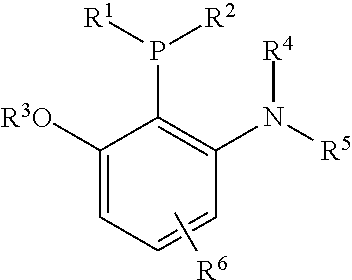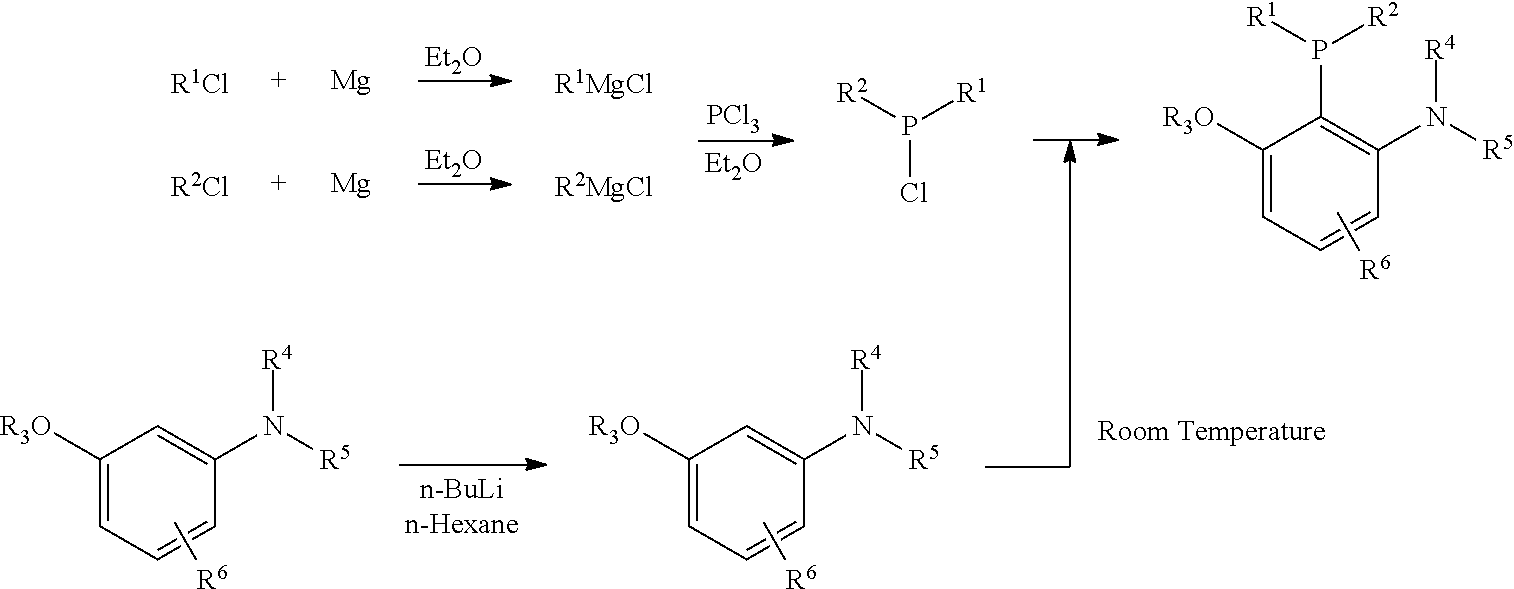Dialkyl(2-alkoxy-6-aminophenyl)phosphine, the preparation method and use thereof
a technology of dialkyl and aminophen, which is applied in the field of dialkyl (2alkoxy6aminophenyl) phosphine, can solve the problems of high cost, large cost, and the failure of the catalyst system to highly selectively catalyze the mono-arylation of ketone with acetyl, and achieves the effect of short route and convenient operation
- Summary
- Abstract
- Description
- Claims
- Application Information
AI Technical Summary
Benefits of technology
Problems solved by technology
Method used
Image
Examples
example 1
Synthesis of 2-Methoxy-6-piperidylphenyl(dicyclohexyl)phosphine
[0034]
[0035]To a flame dried Schlenk vessel were added 1-(3′-Methoxyphenyl)piperidine (385.1 mg, 2.0 mmol) and 2 mL of dry n-hexane under N2. After that, n-BuLi (0.83 mL, 2.5 M in n-hexane, 2 mmol) was added at room temperature. This resulting mixture was allowed to stir at 80° C. for further 3 h to prepare the lithium reagent. When the reaction vessel was cooled down to room temperature, a solution of Cy2PCl (232.7 mg, 1 mmol) in 4 mL of THF was added at room temperature to stir for 13 h. This resulting mixture was quenched with 10 mL of water, extracted with ethyl acetate (50 mL×2), washed with 20 mL of brine, and dried over anhydrous Na2SO4. Filtration, evaporation, and purified by column chromatography on silica gel afforded product (300.4 mg, yield 77%) (petroleum ether / ethyl acetate / triethyl amine=100 / 1 / 1) as a solid: m.p.: 101-102° C. (methanol); 1H NMR (300 MHz, CDCl3) δ 7.24 (t, J=8.1 Hz, 1H, ArH), 6.71 (dd, J1=...
example 2
Synthesis of 2-Methoxy-6-(N-methyl-N-phenyl-amino)phenyl(dicyclohexyl)phosphine
[0036]
[0037]To a flame dried three-necked flask were added N-Methyl-N-phenyl-3-methoxyaniline (9.5482 g, 45 mmol) and 45 mL of dry n-hexane under N2. After that, n-BuLi (18.8 mL, 2.5 M in n-hexane, 45 mmol) was added at room temperature. This resulting mixture was allowed to stir at 80° C. for 2 h to prepare the lithium reagent for the following step.
[0038]To another dried three-necked flask were added PCl3 (2.61 mL, d=1.574 g / mL, 4.11 g, 30 mmol) and 100 mL of dry THF. This solution was cooled to −40° C. and cyclohexylmagnesium chloride (75 mL, 0.88 M, 66 mmol) was added dropwise at this temperature within 6 min. After the addition, the resulting mixture was allowed to stir at rt for 7 h. The above prepared 2-methoxy-6-(N-methyl-N-phenyl)aminophenyl lithium solution was then added in one portion. After 12 h with stirring at 80° C., the resulting mixture was quenched with 100 mL of water. CH2Cl2 (100 mL) ...
example 3
Synthesis of 2-(4′-Methoxyphenyl)-1-phenyl-1-propanone
[0039]
[0040]To a flame-dried and nitrogen filled Schlenk vessel were added Pd(OAc)2 (6.7 mg, 0.030 mmol), 2-Methoxy-6-(N-methyl-N-phenyl-amino)phenyl(dicyclohexyl)phosphine (18.3 mg, 0.045 mmol), t-BuONa (115.4 mg, 1.2 mmol), and p-methoxyphenyl chloride (142.1 mg, 1.0 mmol)) in 1.5 mL of toluene sequentially. After being stirred for about 2 min at room temperature, propiophenone (160.9 mg, 1.2 mmol) in 1.5 mL of toluene were added. The resulting mixture was heated at 110° C. with a preheated oil bath. After 17.5 h, the reaction was complete as monitored by GC. The reaction mixture was then cooled and quenched with 10 mL of Et2O. After transferring the mixture into separatory funnel, the reactor was further washed with 10 mL of Et2O and 10 mL of HCl aqueous solution (5%). The combined mixture was extracted with Et2O (10 mL×2), washed with 20 mL of saturated NaHCO3 aqueous solution, and dried over anhydrous Na2SO4. Filtration, eva...
PUM
| Property | Measurement | Unit |
|---|---|---|
| temperature | aaaaa | aaaaa |
| molar ratio | aaaaa | aaaaa |
| structure | aaaaa | aaaaa |
Abstract
Description
Claims
Application Information
 Login to View More
Login to View More - R&D
- Intellectual Property
- Life Sciences
- Materials
- Tech Scout
- Unparalleled Data Quality
- Higher Quality Content
- 60% Fewer Hallucinations
Browse by: Latest US Patents, China's latest patents, Technical Efficacy Thesaurus, Application Domain, Technology Topic, Popular Technical Reports.
© 2025 PatSnap. All rights reserved.Legal|Privacy policy|Modern Slavery Act Transparency Statement|Sitemap|About US| Contact US: help@patsnap.com



